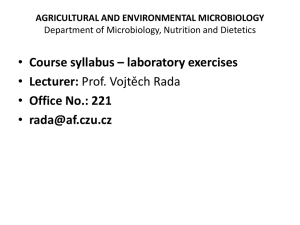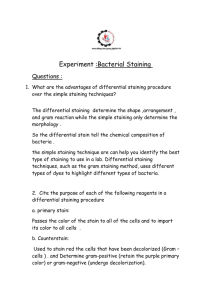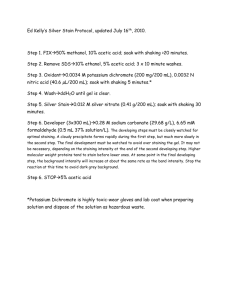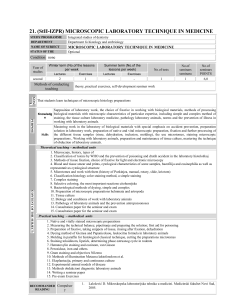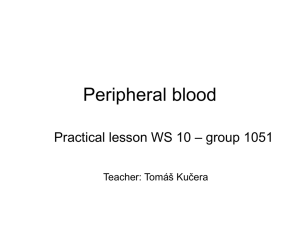Midbrain dopamine function in schizophrenia and major depression
advertisement
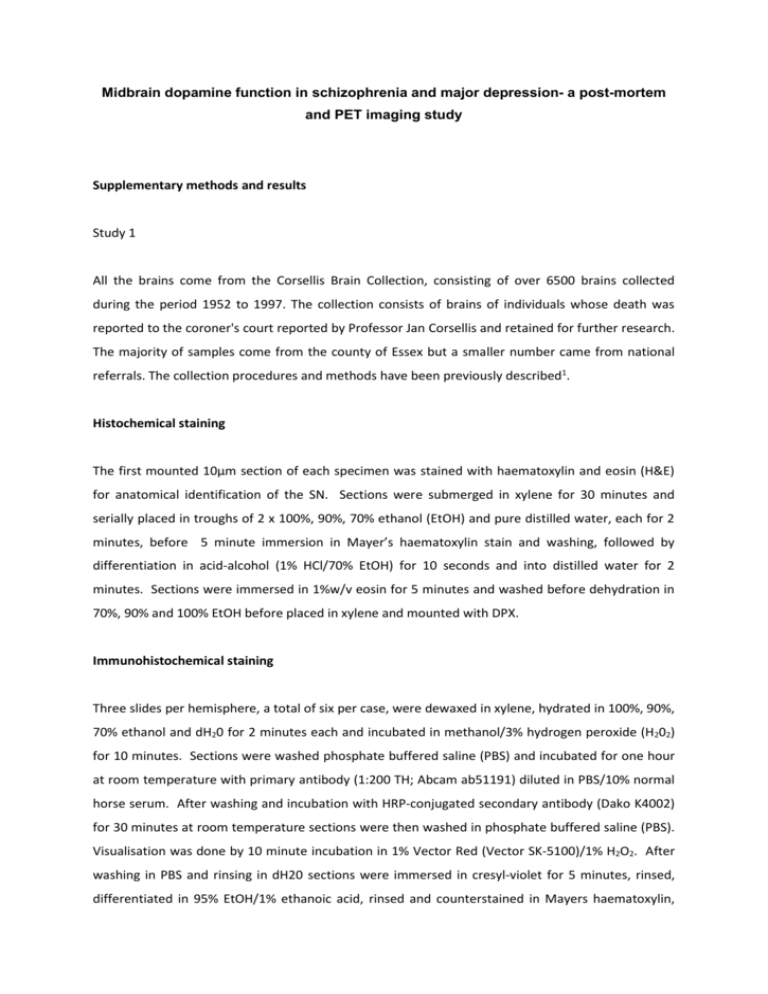
Midbrain dopamine function in schizophrenia and major depression- a post-mortem and PET imaging study Supplementary methods and results Study 1 All the brains come from the Corsellis Brain Collection, consisting of over 6500 brains collected during the period 1952 to 1997. The collection consists of brains of individuals whose death was reported to the coroner's court reported by Professor Jan Corsellis and retained for further research. The majority of samples come from the county of Essex but a smaller number came from national referrals. The collection procedures and methods have been previously described1. Histochemical staining The first mounted 10µm section of each specimen was stained with haematoxylin and eosin (H&E) for anatomical identification of the SN. Sections were submerged in xylene for 30 minutes and serially placed in troughs of 2 x 100%, 90%, 70% ethanol (EtOH) and pure distilled water, each for 2 minutes, before 5 minute immersion in Mayer’s haematoxylin stain and washing, followed by differentiation in acid-alcohol (1% HCl/70% EtOH) for 10 seconds and into distilled water for 2 minutes. Sections were immersed in 1%w/v eosin for 5 minutes and washed before dehydration in 70%, 90% and 100% EtOH before placed in xylene and mounted with DPX. Immunohistochemical staining Three slides per hemisphere, a total of six per case, were dewaxed in xylene, hydrated in 100%, 90%, 70% ethanol and dH20 for 2 minutes each and incubated in methanol/3% hydrogen peroxide (H202) for 10 minutes. Sections were washed phosphate buffered saline (PBS) and incubated for one hour at room temperature with primary antibody (1:200 TH; Abcam ab51191) diluted in PBS/10% normal horse serum. After washing and incubation with HRP-conjugated secondary antibody (Dako K4002) for 30 minutes at room temperature sections were then washed in phosphate buffered saline (PBS). Visualisation was done by 10 minute incubation in 1% Vector Red (Vector SK-5100)/1% H2O2. After washing in PBS and rinsing in dH20 sections were immersed in cresyl-violet for 5 minutes, rinsed, differentiated in 95% EtOH/1% ethanoic acid, rinsed and counterstained in Mayers haematoxylin, rinsed again and dehydrated through serial alcohols, immersed in xylene and mounted using DPX. Following staining slides were randomised and blinded by an independent investigator. Substantia nigra identification H&E stained specimens were viewed under x40 magnification to identify structures anatomically related to the SN, such as the cerebral aqueduct, red nucleus, superior colliculi and cerebral pedunculi. This gave an indication of the rostrocaudal level of the section in anatomical variations. Dopaminergic neurons of the SN were identified by their large size, oval shape and according to the presence of neuromelanin within the cell soma. Image capture and Quantification Images were captured using an Olympus Vanox AHBT 3 micropscope with Q Imaging Micropublisher RTV 3.3 camera and analysed using Image-Pro Plus 5.1 software (Media Cybernetics, US). Sample cells showing no staining, moderate staining and heavy staining were captured at x400 magnification and used as standards. No staining visible in the cytoplasm with clear cresyl counterstain was rated as zero, moderate staining visible in the cytoplasm distinct from neuromelanin as one and heavy staining forming a clear halo around the nucleus and intense staining observed elsewhere in the cytoplasm as two (supplementary figure 1). The medial region of each TH-stained nigra section was imaged at x40 magnification and all dopaminergic cells tagged. These were defined as large, oval stained neurons containing neuromelanin and a counterstained nucleus. A random number generator (www.graphpad.com, US) was used to select eight unique neurons, which were imaged at x400 magnification and semi-quantitatively assessed for TH expression as described above. Study 2 The thirteen patients who were taking medication were taking the following treatment: aripiprazole (n=1), chlorpromazine (n=2), clozapine (n=2), olanzapine (n=6), quetiapine (n=1), risperidone (n=3), sulpiride (n=1). The striatal but not the nigral data from fourteen antipsychotic treated patients and twelve controls has been included in a previous publication2. Exclusion criteria for all subjects were history of neurological or medical illness or head injury, drug or alcohol abuse or dependency, pregnancy, or contraindication to scanning. In addition, all controls were required to have no history of psychiatric illness. PET methods The ECAT/EXACT3D PET scanner (Siemens/CTI, Knoxville, USA) used in the study has a sensitivity of 69 cps/Bq/ml and a spatial resolution of 4.8±0.2 mm. High resolution whole brain images were reconstructed from 95 planes with a slice spacing of 2.425 mm. One hour prior to scanning subjects were given a one off dose of 150mg carbidopa and 400mg entacapone orally. This greatly reduces the formation of radiolabeled metabolites which may cross the blood-brain-barrier, and so improves the specificity of the signal.3 Data acquired in list-mode were rebinned into 26 time frames of increasing duration (1 x 30s, 4 x 60s, 3 x120s, 3 x 180s, 15 x 300s). Data were reconstructed using a 3D re-projection algorithm. A structural MR scan was also conducted to exclude intracranial abnormalities. A mutual information algorithm was used to correct for movement using the images that had not been attenuation corrected.4 The resulting transformation parameters were applied to the corresponding attenuationcorrected frames, and the realigned frames combined to create a movement corrected dynamic image for analysis. Voxel-wise analysis To confirm the results of the ROI analysis at the voxel level, individual parametric (18F-DOPA Kicer) images were constructed from movement corrected images using a wavelet approach.5 The individual parametric images were normalised to MNI space using a decay-weighted 18F-DOPA add image and an 18F-DOPA template in SPM5. To examine sub-regional group contrasts the search volume was restricted to the substantia nigra via application of a nigral mask derived from the HamNet probabilistic atlas.6 Fully corrected results (p<0.05 adjusted for family wise error rate with no extent threshold) are presented for this analysis. Additionally we conducted a whole brain voxel- based analysis to determine the specificity of the differences to the regions-of-interest using a liberal threshold of p<0.01 to ensure high sensitivity, although it should be noted that this increases the risk of type-II error. The results of the whole brain contrast schizophrenia>controls identified two clusters, one in the striatum and one including the right nigra (figure 5a). The contrast controls>schizophrenia identified no significant elevation in controls (figure 5b). Supplementary table 1 Clinical and demographic data for post-mortem samples used (M – male, F – female, NK – not known, SZ – schizophrenia, MDD – major depressive disorder, CoD- cause of death, PMI- post-mortem interval (hours)). Case Age Sex PMI Diagnosis CoD 1 39 M 24 Control Acute Myocardial Infarction 2 40 M NK Control Acute Myocardial Infarction 3 62 M 21 Control Acute Myocardial Infarction 4 68 M 66 Control Multiple Myeloma 5 63 M 28 Control Ischaemic Heart disease 6 52 M NK Control Pneumonia 7 61 M NK Control Ischaemic Heart disease 8 54 F 27 Control Ischaemic Heart disease 9 59 M 68 Control Pulmonary Heart disease 10 46 F 23 Control Acute Myocardial Infarction 11 33 M NK Control Acute myocarditis 12 48 M 25 Control Acute ischaemic heart diseases 13 45 F 66 Control Pneumonia 14 55 M 94 SZ Cachexia 15 40 M 76 SZ Inhalation of gastric contents 16 59 F 119 SZ Congestive heart failure 17 63 F 87 SZ Ischaemic Heart diseases 18 60 M 24 SZ Acute Myocardial Infarction 19 66 M 60 SZ Pneumonia 20 69 M 27 SZ Acute Myocardial Infarction 21 55 M NK SZ Intentional self-poisoning by gases 22 56 F 126 SZ Acute Myocardial Infarction 23 76 F NK SZ Pneumonia 24 66 F 42 SZ Intentional self-poisoning by gases 25 66 M NK SZ Ischaemic Heart diseases 26 60 F NK MDD Intentional self-poisoning by drugs 27 49 F 57 MDD Intentional self-poisoning by alcohol 28 41 M 24 MDD Intentional self-poisoning by gases 29 70 F 48 MDD Pneumonia 30 68 F NK MDD Pneumonia 31 47 F NK MDD Intentional self-harm by suffocation 32 63 M 99 MDD Ischaemic Heart disease 33 54 M 27 MDD Intentional self-harm by fire 34 53 F NK MDD Intentional self-harm by suffocation 35 45 F 66 MDD Intentional self-poisoning by drugs 36 58 F NK MDD Intentional self-harm by suffocation 37 60 F 23 MDD Ischaemic Heart disease 38 65 M 39 MDD Intentional self-poisoning by drugs Supplementary Table 2. Patient data by diagnostic group (M – Male, F – Female, PMI – post-mortem interval (hours), NK – not known, SZ – schizophrenia, MDD – major depressive disorder, CoD=cause of death). Group Total n (n where Mean (SEM) Age/ Sex ratio (M/F) Mean (SEM) PMI/ CoD was suicide) years Control 13 (0) 51.9(2.8) 9/4 39.6(5.4) SZ 12 (2) 60.1(2.3) 7/5 68.5(9.4) MDD 13 (9) 56.5(2.3) 4/9 51.3(6.3) hours Supplementary figure 1. Illustrating the grades of cytoplasmic TH staining used in Study 1. 1a. Illustrating grade 0 staining (indicating low staining for tyrosine hydroxylase). Low/ absent cytoplasmic TH staining with visible cresyl counterstain (pale violet color) is indicated by the arrows labeled A. Staining of neuromelanin, characteristic of dopamine neurons in the substantia nigra, is indicated by the arrow labeled Nm. 1b Illustrating grade 1 staining (indicating moderate staining for tyrosine hydroxylase). Moderate levels of TH staining in the cytoplasm is indicated by the arrows labeled B. Staining of neuromelanin, characteristic of dopamine neurons in the substantia nigra, is indicated by the arrow labeled Nm. 1c Illustrating grade 2 staining (indicating high staining for tyrosine hydroxylase). High levels of TH staining in the cytoplasm with a clear stained halo around cell nucleus is indicated by the arrows labeled C. Staining of neuromelanin, characteristic of dopamine neurons in the substantia nigra, is indicated by the arrow labeled Nm. Supplementary figure 2 2a The nigral region of interest used in study 2 is shown in red on a transverse view of a T1 weighted structural MRI scan in Montreal Neurological Imaging Space. 2b The nigral region of interest is shown (in red within the red circle) following normalisation to native space on the transverse dynamic PET summation images from three patients. Patient 1. Patient 2 Patient 3 Supplementary figure 3 The relationship between nigral [18F]-DOPA uptake and striatal [18F]-DOPA uptake in patients (in red) and controls (in blue). Supplementary figure 4 a. Showing a significant positive relationship between total symptom severity score and dopamine synthesis capacity (Kicer /min) in the substantia nigra (r=0.39, p=0.035) b. Showing a significant positive relationship between psychotic symptom severity score and dopamine synthesis capacity (Kicer /min) in the substantia nigra (r=0.37, p=0.048) Supplementary figure 5 5a. Statistical parametric map for the whole brain voxel-wise contrast schizophrenia>controls showing two clusters where the Kicer values were significantly elevated in schizophrenia (one cluster in the striatum and the other cluster with a peak within the right substantia nigra (indicated by the arrow, MNI coordinates: 12, -18 and -10)). 5b. Statistical parametric map for the whole brain voxel-wise contrast controls>schizophrenia showing no voxels where there is a significant elevation in the controls relative to schizophrenia. References 1. Kasper BS, Taylor DC, Janz D, Kasper EM, Maier M, Williams MR, et al. Neuropathology of epilepsy and psychosis: the contributions of J.A.N. Corsellis. Brain. 2010; 133(Pt 12): 3795-805. 2. McGowan S, Lawrence AD, Sales T, Quested D, Grasby P. Presynaptic dopaminergic dysfunction in schizophrenia: a positron emission tomographic [18F]fluorodopa study. ArchGenPsychiatry. 2004; 61(2): 134-42. 3. Wahl L, Chirakal R, Firnau G, Garnett ES, Nahmias C. The distribution and kinetics of [18F]6fluoro-3-O-methyl-L-dopa in the human brain. J CerebBlood Flow Metab. 1994; 14(4): 664-70. 4. Montgomery AJ, Thielemans K, Mehta MA, Turkheimer F, Mustafovic S, Grasby PM. Correction of head movement on PET studies: comparison of methods. JNuclMed. 2006; 47(12): 1936-44. 5. Turkheimer FE, Brett M, Visvikis D, Cunningham VJ. Multiresolution analysis of emission tomography images in the wavelet domain. J CerebBlood Flow Metab. 1999; 19(11): 1189-208. 6. Hammers A, Allom R, Koepp MJ, Free SL, Myers R, Lemieux L, et al. Three-dimensional maximum probability atlas of the human brain, with particular reference to the temporal lobe. HumBrain Mapp. 2003; 19(4): 224-47.
